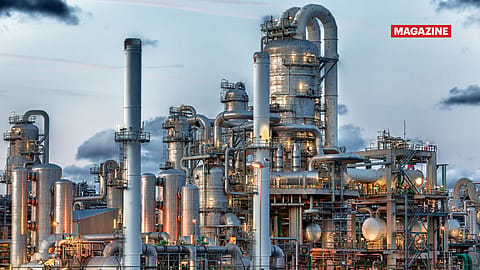Bumpy ride: India’s chemical billionaires are navigating choppy waters, but there's hope
But strategic shifts and domestic demand will help tide over short-term headwinds, say analysts.

This story belongs to the Fortune India Magazine August 2025 issue.
INDIA’S $220-BILLION chemicals industry, producing over 80,000 commercial products, is a key driver of economic growth. As the world’s sixth-largest manufacturer and 14th-largest exporter, India ranks third in chemical manufacturing among Asian nations. With a century-old robust and cost-effective ecosystem, it has fostered several global players across bulk chemicals, agrochemicals, petrochemicals, polymers, and more, making it a breeding ground for billionaires.
However, the 2025 Fortune India-Waterfield Advisors study of India’s Top 100 Billionaires paints a different picture. There are only four pure-play chemical billionaires in the Top 100 — Satyanarayan Nuwal & Kailashchandra Nuwal of Solar Industries India, Madhukar Parekh & family of Pidilite Industries, Arun Bharat Ram of SRF, and Salil Singhal of PI Industries — against six in 2024 and five in 2023. The 2022 list had seven pure-play chemical billionaires among the Top 100, the highest in the past four years.
Tough times
Both 2024 and 2025 were tough years to navigate for most chemical billionaires, barring a few. Despite a much-publicised legal feud between them, brothers Satyanarayan Nuwal and Kailashchandra Nuwal of Solar Industries India saw their combined wealth increase 66.76% to ₹1,15,765 crore in 2025 (as of June 30, 2025). Robust financial performance and opportunities in the defence sector boosted the bottom line of the industrial explosives and ammunitions maker. The company has a strong order backlog of nearly ₹15,200 crore, projected revenues of ₹3,000 crore in FY26, and ₹8,000 crore for the next four to five years, say analysts.
Meanwhile, the wealth of Arun Bharat Ram — chairman emeritus of specialty chemicals and packaging film maker SRF — grew 30.14% to ₹36,269 crore. Investors continued to bet on the SRF growth story, as the firm navigated a challenging H1FY25 by focussing on the domestic market. Net profit rose to ₹1,251 crore on revenues of ₹14,693 crore (a 12% growth) in FY25, according to database provider Capitaline.
Unlike the SRF promoter, Pidilite Industries’ Madhukar Parekh & family’s wealth remained almost flat at ₹1,08,236 crore. Despite a challenging macroeconomic environment and demand conditions, India’s leading manufacturer of adhesives, sealants and construction chemicals performed reasonably well in FY25, riding on the domestic growth story. Net sales grew 6.12% YoY to ₹13,140 crore, while PAT increased 20.06% to ₹2,076 crore.
Meanwhile, Salil Singhal, chairman emeritus, PI Industries, a leading agro-chem maker with a focus on the export markets, saw his wealth decline 7.53% to ₹28,688 crore. The firm had a tough FY25, unlike the past four years, which saw exponential growth in revenues and profits. In FY25, revenues grew 4% YoY to ₹7,978 crore, while PAT saw a marginal 1.27% decline to ₹1,660 crore.
More Stories from this Issue
Sign of the times
The past few years have been challenging for Indian chemical companies. Post-Covid, India emerged as a key player in the global ‘China plus one’ strategy, and the country was seen as a major destination for low-cost quality products. Besides, Indian companies also invested heavily in capacity expansion and value-added products. However, global disruptions — the Russia-Ukraine war, China-U.S. tensions, Middle East instability, and a de-stocking cycle — led to weak demand, pricing pressure, and raw material volatility. The global chemicals industry, which once outperformed the markets, now lags. While global indices have risen 24% annually since late 2022, chemical stocks grew less than 2%, says a recent report by McKinsey & Company. On the performance front, the Indian chemicals sector saw a modest recovery in FY25 after a decline in FY24, with revenue and Ebitda growing 10-15% year-on-year, driven by volumes. However, Ebitda margins remained below the long-term average at 12.5-13.5% due to ongoing pricing pressure from oversupply, says a recent India Ratings and Research (Ind-Ra) study.
“India’s chemicals industry is exposed to evolving risks, from shifting trade dynamics and pricing pressure to supply chain volatility, even as domestic demand remains a bright spot,” says Siddharth Rego, associate director, corporate ratings, Ind-Ra. Most firms navigated the challenges with a strong focus on the domestic market, he adds.
“Last year was challenging for the Indian chemicals industry, but the long-term outlook remains bright,’’ points out Viswanathan Rajendran, partner, Kearney India. According to Ind-Ra, the sector’s balance sheet remains stable and despite pricing headwinds, it has adequate borrowing capacity and liquidity to manage volatility. Nearly 90% of rated entities have comfortable liquidity positions, with net leverage improving to 1.0-1.25 times in FY25, from 1.3-1.4 times in FY24. Around 33% of domestic chemical firms had a net cash position last fiscal.
(INR CR)
Rajendran says four big themes are shaping growth — a strong and growing domestic petrochemicals market with sizeable import substitution opportunities; a capability-led specialty chemicals export play; a stable domestic agrochemicals base; and a shift towards green chemicals.
As the cycle turns, firms investing in scale, integration, capabilities, and cleaner technologies will pull ahead, cementing India’s role in global supply chains.

